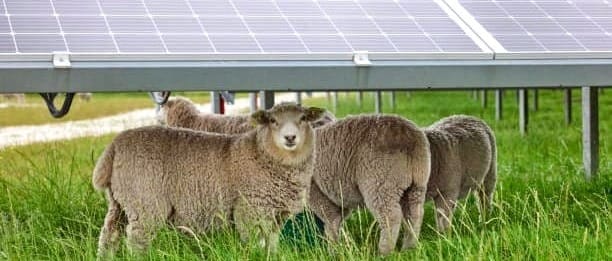From Sheep to Sustainability: The Innovative Marriage of Agriculture and Renewable Energy

In the face of the climate crisis, businesses are thinking outside the box to find innovative solutions that promote sustainability. One such approach that has taken the world by storm is the integration of agriculture and renewable energy. By combining these two seemingly unrelated sectors, companies are not only reducing their carbon footprint but also creating new job opportunities and boosting efficiency in both industries.
Enter solar grazing, a concept that has captured the hearts of environmentalists and investors alike. Picture this: a sea of solar panels stretching across the landscape, with fluffy sheep happily munching away at the vegetation beneath. It's a sight that's both adorable and eco-friendly! Solar grazing offers a multitude of benefits, from reducing the need for manual labor to preventing shade from obstructing sunlight. Plus, it provides a natural and chemical-free way to control plant growth. After decades of lagging demand for wool and lamb meat, solar grazing is giving some farmers a side-hustle revenue stream (~$1/acre grazed) and free food for their sheep, which helps solar companies garner local support for their ventures.(1)
But the marriage of agriculture and renewable energy doesn't stop there. Another exciting development is the rise of agrivoltaics, a system that combines solar panels with crop production. By installing raised solar panels above crops, farmers can generate clean energy while still using the land for agricultural purposes. Agrivoltaics benefits include shade, reduced heat damage to crops, and increased water availability for crops by capturing fog moisture. Several research studies have shown that the co-location of plants underneath solar panels creates a beneficial microclimate for both the solar modules and crops.(2,3) Researchers have found that solar PV can create a cooler environment (3) improving panel performance, while the increased shade can improve water-use efficiency, soil moisture content, and crop yields. For example, within the study cherry tomato production doubled in the agrivoltaics system and water-use efficiency for the crop was 65% greater than normal growing conditions.(4)
But it's not just about solar power. Wind energy companies are also getting in on the action by integrating their turbines with farmland. By leasing land from farmers to install wind turbines, these companies provide a new source of income for agricultural communities while generating clean energy. In fact, wind turbines can generate up to $4,000 per year per turbine for farmers (5). And the best part? The space between turbines can still be used for grazing or crop production, maximizing land use efficiency.
However, it's important to note that the integration of agriculture and renewable energy is not without its challenges. The initial cost of installing renewable energy infrastructure can be a barrier for some farmers, and there are concerns about the long-term impacts on soil health and biodiversity. Additionally, the aesthetic impact of solar panels and wind turbines on rural landscapes has been a point of contention for some communities.
Despite these challenges, the benefits of combining agriculture and renewable energy are too significant to ignore. By diversifying income streams, farmers can enhance their financial resilience and reduce their vulnerability to market fluctuations and weather-related risks. Plus, these innovative approaches create new job opportunities in both sectors, from skilled shepherds for solar grazing to technicians for agrivoltaics and wind energy integration.
As the world grapples with the urgent need to address climate change, innovative solutions like the marriage of agriculture and renewable energy will play a crucial role in building a more sustainable future. By thinking creatively and embracing new approaches, businesses can not only reduce their environmental impact but also create new economic opportunities and contribute to the well-being of communities. The synergy between sheep, solar panels, and sustainability is just the beginning of a promising trend that has the potential to transform the way we approach both agriculture and energy production. So let's raise a glass (of organic, locally-sourced wine, of course) to the innovative thinkers who are paving the way for a greener future!
Comments ()